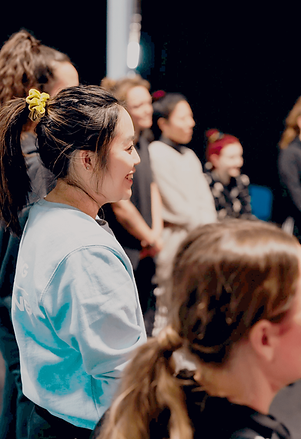ACL Injuries And The Rehabilitation Journey
- Clarice Liu
- Aug 27, 2024
- 3 min read
Updated: Oct 8
Cheerleading, tumbling, and acrobatics are exhilarating sports that demand incredible athleticism.
The repetitive high-impact landings and twisting motions place immense stress on the body, particularly the knees. Amongst gymnasts, the knee is the most commonly injured joint (1).
Within the knee joint, the Anterior Cruciate Ligament (ACL) has been suggested to be the most frequently injured knee ligament, with ACL injuries constituting almost half of all knee injuries (2).
This blog will delve deeper into ACL injuries and how the rehabilitation journey can look.
ACL Recovery: A Comprehensive Guide
An ACL injury is a common sports-related trauma that requires a structured rehabilitation process. This blog post will delve into the key components of ACL recovery, including the renowned Melbourne Protocol, ACL graft types, and the stages of exercise progression.
Understanding the Melbourne Protocol

The Melbourne Protocol is a widely respected rehabilitation program designed to guide ACL recovery from the initial injury to a total return to sport. It emphasizes a progressive and individualized approach, ensuring optimal outcomes.
The protocol consists of six phases:
Pre-operative: This phase focuses on reducing pain and swelling and restoring the knee's range of motion before surgery.
Recovery from surgery: Immediate post-operative care, including pain management, swelling control, and early range of motion exercises.
Strength and neuromuscular control: Building strength and stability in the knee joint, focusing on challenging balance and coordination exercises.
Running, agility, and landings: Gradual progression to running, incorporating agility drills and plyometrics to prepare for sport-specific demands.
Return to sport: Transitioning to full sports participation, focusing on sport-specific training and performance optimization.
Prevention of re-injury: Ongoing exercises and strategies to reduce the risk of ACL re-injury.
Types of ACL Grafts
ACL reconstruction surgery involves replacing the torn ligament with a graft. Several graft options are available:
Hamstring tendon graft: Using tendons from the back of the thigh.
Patellar tendon graft: Using the tendon from the kneecap.
Allograft: Using donor tissue from a deceased person.
The graft choice depends on the patient's age, activity level, and surgeon's preference.

Stages of Exercise Progression for ACL Rehabilitation
ACL rehabilitation is a gradual process involving progressive exercise challenges. The following stages outline the general progression:
Early Stage:
Focus on reducing pain and swelling and restoring range of motion.
Exercises include gentle cycling, straight leg raises, and quad sets
Intermediate Stage:
Building strength and stability through closed-chain exercises (e.g., squats, lunges).
We are incorporating balance and coordination drills.
Introducing low-impact plyometrics (e.g., box jumps, hops).
Advanced Stage:
High-intensity plyometrics and agility training.
Sport-specific drills and simulations.
Gradual return to running and cutting manoeuvres.
Return to Sport:
Full participation in sports activities.
Ongoing strength and conditioning to prevent re-injury.
Important Note: This information is intended for general knowledge and informational purposes only and does not constitute medical advice. Always consult with a healthcare professional for personalised guidance and treatment.
The Importance of Neuromuscular Control in ACL Recovery
Neuromuscular control is often overlooked in ACL rehabilitation, yet it is critical for a successful recovery and return to sport. It refers to the nervous system's ability to coordinate muscles and joints to produce smooth, efficient movements.
Why is Neuromuscular Control Important?
Prevents Re-injury: Impaired neuromuscular control is a significant factor in ACL re-injury. Strengthening the muscles and improving coordination can significantly reduce the risk of future injuries.
Enhances Performance: Optimal neuromuscular control is essential for explosive movements, agility, and balance, which are crucial for athletic performance.
Reduces Pain: Improved neuromuscular control can help alleviate pain by optimizing joint mechanics and reducing stress on the knee.
Improves Function: Daily activities like walking, running, and jumping require proper neuromuscular control. Restoring this function allows individuals to return to their normal lifestyle more quickly.
How is Neuromuscular Control Trained?
Neuromuscular control training involves exercises that challenge balance, coordination, and reaction time. Some examples include:
Balance exercises: Stand on one leg, do foam pad exercises, and use wobble boards.
Coordination drills: Plyometric exercises, agility ladders, and change of direction drills.
Proprioceptive training: Exercises that challenge the body's sense of position, such as exercises on unstable surfaces or with closed eyes.
Learnt more about self-help ways to support your ACL injuries, listen to our podcast:
It's important to note that neuromuscular control training should be progressive and supervised by a qualified professional. Incorporating neuromuscular control exercises into your ACL rehabilitation program can significantly improve your chances of full recovery and return to sport.
__________________________________________________________________________________
References
Epidemiology of injuries in elite Women’s Artistic Gymnastics: a retrospective analysis of six seasons, https://bmjopensem.bmj.com/content/9/4/e001721
Anterior Cruciate Ligament Knee Injury, https://www.ncbi.nlm.nih.gov/books/NBK499848/#:~:text=The%20ACL%20is%20the%20most,approximately%201%20in%203500%20people.
Our blogs and articles are not designed to replace medical advice. If you have an injury, we recommend seeing a qualified health professional. We offer both in-person assessments and online consultations!



.png)





Comments